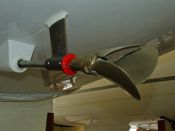
Which prop - feathering, folding or fixed?
There are a couple of distinct schools of thought on the best propeller for a yacht. On the one hand are sailing purists who believe propellers are only needed for getting out of marinas or motoring into port. In the opposite camp are many so-called sailors who use the motor as their main propulsion, relying on it when they can’t sail effectively or are too lazy to do so.
Most of us fall between these extremes. We need to consider what we are prepared to sacrifice for acceptable engine propulsion. There is a saying that in choosing a yacht we can only have two out of the three attributes of speed, economy and comfort. With propellers it’s more a choice between performance, cost and longevity.
Topping the list for performance under power and sail are various incarnations of the feathering propeller. The blades are adjustable for maximum thrust in both forward and reverse, yet rotate to a fore and aft position for minimum drag when sailing. The downside is they are very expensive, require regular maintenance and can be damaged more easily than fixed props. Pot warps are not their friend, neither is flotsam or stray logs, as I once found to my cost in the Sealark Channel along the north coast of Guadalcanal.
Fixed three-blade propellers provide excellent motoring performance without draining the budget. With no moving parts or fiddly bits they are virtually maintenance free, but have a major detrimental effect on sailing speed. Quite literally like dragging a bucket, whether or not they are allowed to rotate. That the freely rotating prop is faster under sail can be proved by checking your speed with the prop fixed or turning. For most boats there will be about a knot of difference.
Two-bladed fixed props can be aligned vertically to reduce drag under sail, but are not very effective in their primary role of driving the boat under power. Stopping power in reverse is minimal. Yacht-specific narrow blade fixed propellers which are claimed to reduce drag are available in both two and three blade versions.
Folding propellers vary from fairly basic to sophisticated geared props which are quite efficient. The better ones provide more than adequate performance both ahead and astern, with negligible sailing drag. For easily driven lightweight yachts they could be an excellent compromise.
On top of this is the question of whether to sail with the engine in our out of gear, and if the former, which gear to choose. Some, such as Yanmar saildrives, specifically require the motor to be in neutral while sailing. Others say that letting the shaft turn leads to unnecessary wear, and can damage the transmission. If you’re like me, and the noise from the rotating shaft drives you nuts, or if you are concerned about damage, you may be able to add a shaft lock, however this adds a layer of complication – as well as the need to remember to unlock it, which is contrary to the KISS (Keep It Simple, Silly) principle many of us admire. So although it’s out of sight, your prop should be kept firmly in mind, at least until you are sure you are treating it right while under sail.